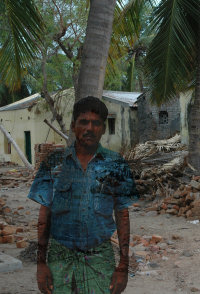© 2007 All Rights Reserved. Do not distribute or repurpose this work without written permission from the copyright holder(s).
Printed from https://danginteresting.com/the-association-of-the-dead/
This article was written by Gerry Matlack, one of our shiny new Dang Interesting writers.

In 1976, a farmer in northern India became alarmed when he was informed of his own death. Lal Bihari was in the process of applying for a loan when the bank representative delivered the bad news, and it wasn’t just that his loan had been denied. He was clearly a breathing, animated, fifteen-year-old, and he exhibited none of the classic symptoms of zombiism, yet government records indicated that he was no longer among the living. There was even a death certificate bearing his name.
There was no arguing that he appeared to be alive, but such evidence turned out to be insufficient to correct the error. After some investigation Bihari learned that his situation was not due to some administrative blunder, but rather it was due to an act of fraud. An unscrupulous uncle had bribed a government worker to provide a false death certificate, as well as bribing another fellow at the local Land Registry Office. For less than $100, the uncle had gained the title to Bihari’s farmland in Uttar Pradesh, leaving no legally living soul to challenge the claim. As Lal Bihari began the lengthy effort to bring himself back to life and reclaim his stolen lands, he discovered that there were many others like him, and that the death-by-paper practice was widespread in the region of India known as the “badlands.”
In order to bring attention and justice to the throngs of the undead , Bihari formed Mritak Sangh, the Association of the Dead. Many were worse off than he, suffering beatings and threats from the family members who had defrauded them. Many of them were even in danger of losing their real lives at the hands of those who had profited from their “demise.” No land owner was completely safe from the treachery, including a a man named Maha Prasad who worked as a police constable for six years while legally dead. Over time, Mritak Sangh’s membership grew over 10,000— with some estimates as high as 20,000— though no official tally has ever been made. Apparently the culture of fraud and theft is fertilized by a mixture of scarce farmland, high crime rate, and fierce family rivalries.
For eighteen years Bihari battled the bureaucracy and corruption in an effort to once again be listed among the living. Finding that all official channels led to dead ends, Bihari resorted to more dramatic measures. He arranged his own funeral, applied for a widow’s pension for his wife, kidnapped the son of the uncle who stole his land, threatened murder, threw leaflets at lawmakers, publicly insulted judges, and even tried running for Prime Minister. He went so far as to add the word “Mritak”— meaning “dead”— to the end of his name. “The Late Lal Bihari” created these public scenes in hopes of being arrested and thereby forcing the government to acknowledge his existence, but each time he was merely beaten by police or rebuked for wasting officials’ time.
At long last, in 1994, a local District Magistrate helped restore Bihari to legal life and his lands were returned to him. He was thirty-three years old. After over eighteen years as a dead man— more than half of his life— he relinquished the land to the very uncle who had originally arranged for his premature death. His uncle was so ashamed that he begged Bihari for forgiveness.
Following his own success, Lal Bihari the Living has continued his efforts to raise the dead in India’s badlands. At an official tally in 1999, the Association of the Dead had helped to resurrect roughly thirty people by virtue of having their death certificates annulled, but of those thirty only four have had their lands restored. In 2003 Bihari was awarded the Ig Nobel Peace Prize— a parody of the famous Nobel Peace Prize— citing his extensive and selfless “posthumous activities.”
It is rumored that India’s movie capital of Bollywood is planning to produce a film adaptation of Bihari’s near-death experience. Perhaps such a movie will help bring needed attention to the thousands of walking undead whose lands have been misappropriated by ruthless family members, and help bring an end to this widespread practice. After all, trifling with zombies rarely—if ever—works out for the best.
© 2007 All Rights Reserved. Do not distribute or repurpose this work without written permission from the copyright holder(s).
Printed from https://danginteresting.com/the-association-of-the-dead/
Since you enjoyed our work enough to print it out, and read it clear to the end, would you consider donating a few dollars at https://danginteresting.com/donate ?